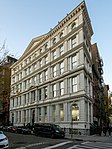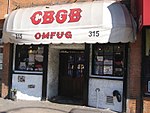CBGB was a New York City music club opened in 1973 by Hilly Kristal in Manhattan's East Village. The club was previously a biker bar and before that was a dive bar. The letters CBGB were for Country, BlueGrass, and Blues, Kristal's original vision, yet CBGB soon became a famed venue of punk rock and new wave bands like the Ramones, Television, Patti Smith Group, Blondie, and Talking Heads. From the early 1980s onward, CBGB was known for hardcore punk.One storefront beside CBGB became the "CBGB Record Canteen", a record shop and café. In the late 1980s, "CBGB Record Canteen" was converted into an art gallery and second performance space, "CB's 313 Gallery". CB's Gallery was played by music artists of milder sounds, such as acoustic rock, folk, jazz, or experimental music, such as Dadadah, Kristeen Young and Toshi Reagon, while CBGB continued to showcase mainly hardcore punk, post punk, metal, and alternative rock. 313 Gallery was also the host location for Alchemy, a weekly Goth night showcasing goth, industrial, dark rock, and darkwave bands. On the other side, CBGB was operating a small cafe and bar in the mid-1990s, which served classic New York pizza, among other items.Around 2000, CBGB entered a protracted dispute over allegedly unpaid rent amounts until the landlord, Bowery Residents' Committee, sued in 2005 and lost the case, but a deal to renew CBGB's lease, expiring in 2006, failed. The club closed upon its final concert, played by Patti Smith, on October 15, 2006. CBGB Radio launched on the iHeartRadio platform in 2010, and CBGB music festivals began in 2012. In 2013, CBGB's onetime building, 315 Bowery, was added to the National Register of Historic Places as part of The Bowery Historic District (not a New York City Historic District).




